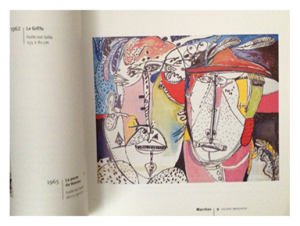Unity. Interesting term. What does it signify? What is the value of a unifying force, a unifying theme, a unifying approach? As part of this month’s “By Invitation Only,” we are interpreting the meaning of unity, in any domain or fashion we might like. And in a time of divisiveness in the “United” States, what could be more relevant?

The dictionary definition of unity points us toward a breadth of interpretations, offering notions of joining, agreement, and harmony. Might we think of nature’s integration of seemingly opposing forces? Might we think of the dramatic differences in the U.S., or any country for that matter, as we move from state to state or region to region?
Might we think of the way the composer’s selection of instruments and the artist’s provocative palette offer sensory pleasure in their rich, satisfying, sometimes surprising harmonies?
 For me, unity celebrates diversity, which does not negate or diminish uniqueness. Unity also demands leadership — true and effective leadership — that neither hides nor dismisses key skills and talents, the need for them, or the recognition of those who are outstanding in their mastery.
For me, unity celebrates diversity, which does not negate or diminish uniqueness. Unity also demands leadership — true and effective leadership — that neither hides nor dismisses key skills and talents, the need for them, or the recognition of those who are outstanding in their mastery.
For me, unity speaks to the best of us. We are often at our best when times are at their worst: Consider the hurricanes and earthquakes that have hit in recent years, and the ensuing acts of heroism. Consider the many humanitarian missions around the world that so many good people give their time and energy and money to support.
When people are in trouble, we don’t stop and think about how much money they make or what their political party may be, much less the hue of their skin or their sexual orientation. Instead, we bear witness to extraordinary examples of reaching out and banding together — we help — each of these acts of assistance an affirmation of our common humanity.
While I believe we are more unified than we are separated, we may focus on our differences with such fierce intensity that we cannot see the “unity of art” in our colorful forest for the frequently in-your-face attributes of individual trees.

There are other ways to reflect on “unity,” of course. We could talk about unity in design — from pleasing and usable web pages to comfortable and comforting spaces in which to live and work. We could examine all the elements of light, space, color, form, texture, placement of objects (and more) that comprise a complete “whole” that functions as needed. And makes us feel good!
As one who is highly influenced by my visual surroundings, when something is off — the proportions of furniture, colors, texture — I feel it. I may not be able to articulate exactly what needs to be done — those of you who are designers can, thankfully — I sense that something isn’t right, and consequently, I don’t feel right in its presence.
On the other hand, I can often tinker my way to a reasonably harmonious space wherever I am living. It generally includes plenty of black, white, and red — red being my “happy” color — and comfort-inducing (fabric) textures.
Similarly, if I am sitting in a room with art that grates on me… eesh! It impacts my mood, and not in a good way.
 Speaking of which, unity in art involving compositional elements (colors, form, balance, and so on) is a fascinating subject. And as I look around my rooms at my favorite artworks — some created by friends, some by one of my sons, some that I have collected in my travels over the years — I note that what characterizes them is their mastery of unifying, often tension-inducing elements, that nonetheless work together as a cohesive and compelling whole.
Speaking of which, unity in art involving compositional elements (colors, form, balance, and so on) is a fascinating subject. And as I look around my rooms at my favorite artworks — some created by friends, some by one of my sons, some that I have collected in my travels over the years — I note that what characterizes them is their mastery of unifying, often tension-inducing elements, that nonetheless work together as a cohesive and compelling whole.
The mention of tension is important. Who says that a unifying whole is without its sources of conflict? Isn’t tension what grips us in a riveting work of fiction? Isn’t the electricity of differences an essential element of chemistry in a romantic relationship? Why would we think that society as a whole, rich in diversity, wouldn’t also include some necessary and useful aspects of tension? Differences that stretch us, and ultimately keep us going and growing for the better?
That said, conflict and tension, when excessive — and yes, that’s a subjective determination — can be destructive. This, sadly, is where we seem to be in our political discourse in the U.S. these days. And it’s an excellent reason to pull back and to take the rhetoric down a notch. Let us use our maturity and capacity for independent thinking to stay open, to listen carefully, to observe keenly, and to seek points of commonality to help us map a path to meaningful unity.

Image, p. 9, my copy of catalogue, Macréau, Galerie Alain Margaron, Paris.
What a brilliant definition of unity Wolfie ….. and, as in your last paragraph, something we all need to take heed of. So much thought has gone into your piece and so beautifully written as always. XXXX
Differences can be respected as we all strive toward a common goal. For a long time, that goal was a better life for all. It’s harder when the goal is winner take all.
Great approach to the theme, D.A. — I especially like the paragraph on tension as a necessary part of Unity — but the dangers of too much. And I love the colourful photographs you’ve chosen to make your point.
Thanks, again, for organizing the link-up. Off now to read the other contributors.
I can’t believe you “pulled together” that wonderful piece of writing jet-lagged, Frances! What a pleasure to read. Thanks so much for participating! (Hey everyone… be sure to pop over to Frances’ blog and read. And to Karin’s, too. And all the others!)
I think the part of people uniting at times of national emergencies says all this the best. If, at all other times, we could just stop and listen, without comment or criticism, we would all be so much better people. My opinion is only valid if I’m certain I’m correct and during these times that is very difficult. xx’s
I really loved the theme this month, D.A. Love what you said about differences creating unity. Reminds me of the high school where Stu taught for many years. How diverse it was, and how he always said that the kids from such various ethnic and language backgrounds didn’t even seem to notice their differences. They just all got along.
The theme was Marsha‘s idea, and I think it was a terrific one. I love your mention of the diversity in schools. My kids also went to (public) schools – and in elementary – with more nationalities represented than the private international school nearby. It’s amazing how kids just deal with each other as equals and individuals, without a second thought. The more we can travel and be exposed to different cultures, not to mention languages, the better, in my book. It opens our eyes and our worlds, something that you know from all of your travel.
Simply BRILLIANT !!
xk